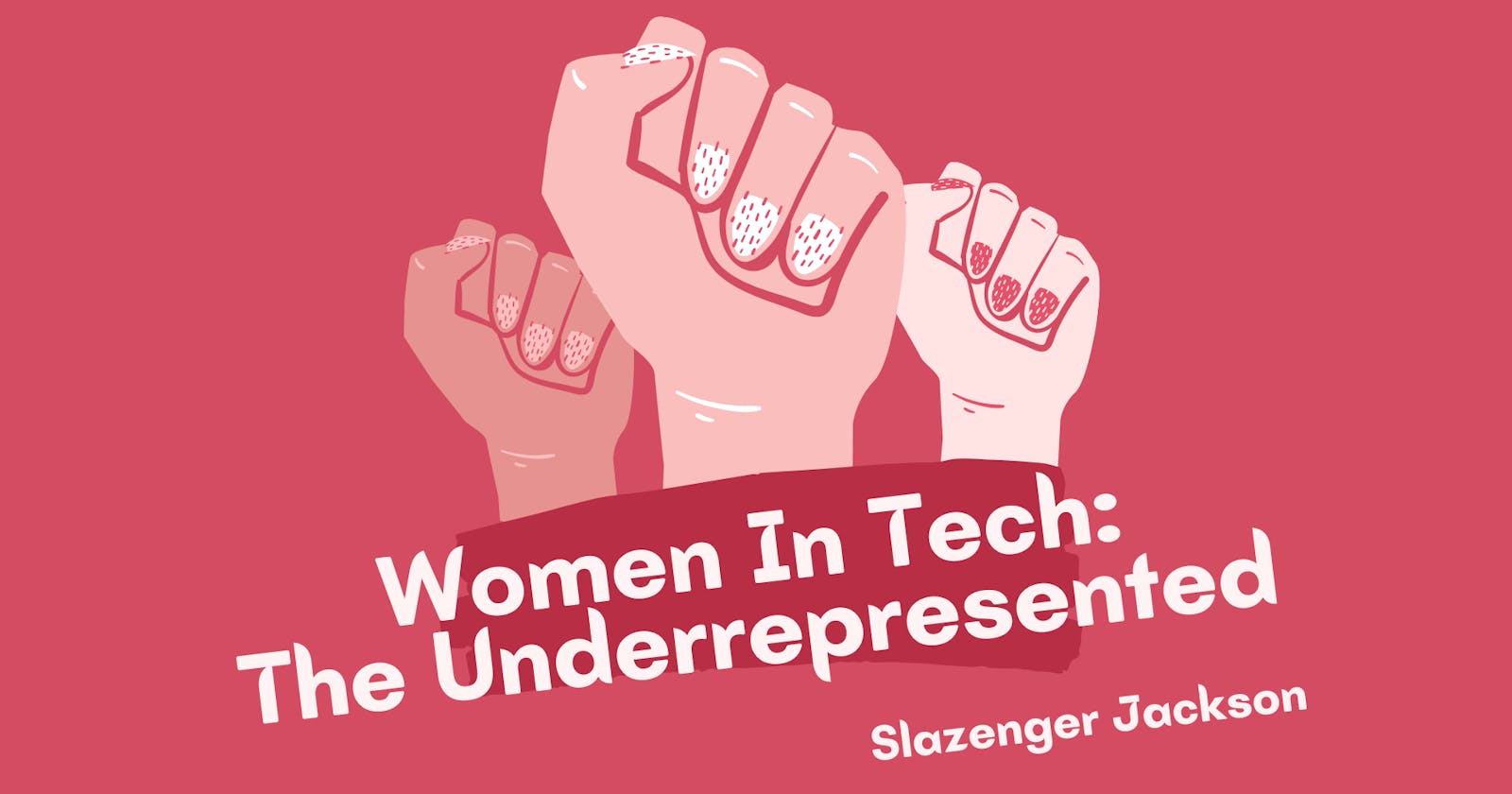Women are underrepresented in the tech sector —myth or reality?
Despite national conversations about gender diversity in tech, women are still underrepresented, underpaid and often discriminated against in the tech industry.

Women are under-represented in the tech sector. Not only that, but they’re underpaid, often passed for promotions and faced with every day sexism.
Let’s face it, tech still has an issue with gender diversity. The tech sector sadly lags behind the rest of the job market when it comes to hiring women. As the percentage of employed women across all job sectors in the US has grown to 47%, the five largest tech companies on the planet (Amazon, Apple, Facebook, Google and Microsoft) only have a workforce of about 34.4% women. While controversial technologies or flashy CEOs get most of the negative airtime, it’s the lack of women in the tech industry that seems to be the largest problem looming overhead.
Diversity is critical in tech, as it enables companies to create better and safer products that take everyone into consideration, not just one section of society. A report from McKinsey found that diverse companies perform better, hire better talent, have more engaged employees and retain workers better than companies that do not focus on diversity and inclusion. Despite this, women remain widely underrepresented in IT roles.
A lack of gender diversity carries with it a major opportunity cost, both for individual tech companies and the entire sector. Diverse teams, including those with greater gender diversity, are on average more creative, innovative, and, ultimately, are associated with greater profitability. This strong positive correlation between higher levels of employee diversity and stronger financial performance has been demonstrated consistently across sectors and geographies, and tech is no different. Plus, tech companies’ recent public struggles on gender-related issues have demonstrated there are real, immediate costs that result from a lack of inclusion and diversity—lost stock value, lower market share, HR costs, and public relations costs, among others.
There is no question that the tech sector can help create a brighter future for women and girls in tech. Through a survey of 32 leading tech companies representing nearly $500 billion in revenues and slightly more than $500 million in philanthropic giving in 2017, as well as extensive interviews with approximately 40 tech-company leaders, I've found evidence of why, exactly, current philanthropic and CSR efforts are falling short. Tech company action today will create opportunities for women to lead innovation tomorrow.
WOMEN IN TECH TODAY (WHAT'S GOING ON?)
 The lack of diversity in the global tech sector is not a recent phenomenon; it has been a significant and consistent challenge for tech companies for many years. From tech start-ups to Fortune 500 industry anchors, tech companies of all sizes recognize that their workforce continues to draw mainly from a small segment of the talent pool—predominantly white and Asian men from elite educational institutions. Drawing from a narrow talent pool leaves money, innovative ideas, and star employees on the table—and potentially exposes organizations to criticism and reputational risk.
The lack of diversity in the global tech sector is not a recent phenomenon; it has been a significant and consistent challenge for tech companies for many years. From tech start-ups to Fortune 500 industry anchors, tech companies of all sizes recognize that their workforce continues to draw mainly from a small segment of the talent pool—predominantly white and Asian men from elite educational institutions. Drawing from a narrow talent pool leaves money, innovative ideas, and star employees on the table—and potentially exposes organizations to criticism and reputational risk.
With more women leaving the industry, it makes having role models at the top increasingly difficult. This further adds to the image of a male-dominated tech world and adds to the cycle of female discouragement. As Linda Davis, CEO of Next Generation Recruitment points out, having key women in senior leadership roles will positively encourage other females to join an organization that is supportive of advancing women’s careers, thus increasing overall company growth and productivity.
This lack of women taking up tech-related degrees translates into the workforce, where at many tech companies, males form the overwhelming majority. This leads to women experiencing sexism and feeling like they don’t belong. According to a survey by The Guardian, 73% of workers in the tech industry believe the industry is sexist. With news stories of sexism rife in the industry, it’s clear there is a work culture problem of ‘brogrammers’ that needs addressing.
But besides sexism, role models and stereotypes, the industry makes it difficult to combine having a tech career with motherhood. In a recent study reported in Fortune, 85% of 716 women surveyed who have left the tech industry cite maternity leave policy as a major factor in their decision to leave. Tech employers who aren’t supportive of their female staff and don’t offer flexibility in working can only further discourage females from joining up.
CAUSES OF GENDER DIVERSITY IN TECH
 A staggeringly low 16% of employees in the tech industry are women.
A staggeringly low 16% of employees in the tech industry are women.
In the United States, the number of women in tech has declined steadily since 1984. In Britain, only 13% of women aspire to work in the industry compared to 36% of men – and the majority of other countries are in the same sinking boat. India is one of the few countries to be edged with a silver lining, boasting an almost equal number of STEM (Science, Technology, Engineering, and Mathematics) male and female college graduates.
Why are so few women working in the innovative, challenging, expansive world of the tech industry?
Back to school: Let’s start at the beginning and go back to the classroom, where children, sponge-like and eager as beavers, tackle new subjects every day.
Classroom customs and gender stereotypes: “We can reverse the trend of women in tech and build a more supporting ecosystem from early childhood up through formal education and far into someone’s career.” – Catherine Ashcraft, Director of Research for the NCWIT
Education is the first hurdle that women meet on their path to tech. Teachers and female students are having to push against the tide of gender stereotype ‘boys are better at science and maths’ and what some dub the general ‘pinkification‘ of girls.
Young women in pink: perception of women in tech What’s pink got to do with it?
The perception of women in tech is deep-seeded, shaping how girls consider their abilities with STEM subjects. Toss in far from dynamic ways of teaching STEM – uninspiring note taking and memorisation – and you can understand why few young female students set out on a passionate and deliberate journey into tech.
Monica Eaton-Cardone, co-founder of Chargeback Company, goes as far as to say that independent subject choosing should be removed. She feels that girls need time to progress with tech-centric subjects that they may have an aptitude for – but drop because of preconceived ideas on their ability.
An uninspiring recruitment approach: “Instead of blaming women for not having sufficient interest in technology careers, we have to honestly, humbly ask ourselves: why is tech so unwelcoming to women? What is telling women that they should not even bother to try?” – Tarah Wheeler, Author of Women in Tech
Against the odds, handfuls of young women make it to university to read their STEM subject. However, approximately only 26% of women who graduate go on to work in tech, compared to 40% of men. How come?
As young graduates or as tech professionals looking to grow, these two familiar scenarios tend to ensure that women are intimidated and discouraged from continuing on their tech journey:
Lack of female role models: You’d think (wouldn’t you?) that an easy way to show that women are valued and at the forefront of a company would be to represent them in the number of female speakers/interviewers during the recruitment process. Sadly, there’s a lack of female role models included in these first crucial steps of the hiring process.
A female candidate who sees few or no female role models at a recruitment day (or at an interview) may struggle to see herself joining said company. She may wonder if the company will support her in terms of progression and job satisfaction.
It’s a vicious circle: there are few women in tech, female tech candidates see few female role models and are discouraged from pursuing tech – and the downhill tumble continues.
With few female leads and a male-dominated attendance at tech recruitment days, the general environment can spiral into a competitive volley of technical know-how and one-upmanship and become unwelcoming for women.
Male-orientated approach to tech: According to Dr. Aurélie Jean, the tech industry needs to adapt to a female audience, rather than relying on a ‘one size fits all’ blanket sell. Jean’s view is that the female audience is more sensitive, interested in purpose at work, and that tech discourse should be adjusted with this in mind. Jean also feels that the ‘bro culture’ in tech companies needs shaking up in order to allow for gender diversification in the industry.
Societal influence and Geek culture: ‘Geek culture’, as we know it today, has been around for over a decade. Shows like The Big Bang Theory and the Marvel movies have ramped up the mainstreaming of nerd culture, connecting ‘geek’ with ‘chic’ like never before. The problem with this evolved geek culture? It’s a male dominated world and its associations with the tech industry create a less than easy space for women – and those who are not in the geek know – to slot in to.
“The geek culture is fun, funny, but it is discriminating and somewhat exclusionary.” – Salwa Tok, Founder and President of Becomtech
An exclusionary point that’s often highlighted is the geeky and often gender stereotypical references used within tech recruitment days, workshops and networking events. Pitching companies use images of scantily clad women or male-only working scenes in their presentations, for example. This at least alienates and at most completely deters the female audience.
Even when women are involved and interested in geek culture, it’s often assumed by their male counterparts that they’re not.
“I will never forget the time I had been thoughtlessly excluded from the all-male C-suite poker games at a previous company… and I am a poker player!” – Tarah Wheeler, Author of Women in Tech
WHAT SHOULD WE DO?
 Many companies do not apply a gender lens to their CSR and philanthropy. Despite many leaders’ stated desire to bring more women into the sector, most companies do not invest significantly in improving the gender diversity in tech through their philanthropy. In 2017, only around 5 percent ($26 million) of companies’ philanthropic giving went to programs with an explicit focus on women and girls in tech. Without deliberately focusing on women’s representation in programs that prepare people for careers in tech, companies risk replicating the same gender ratios we see in the sector today.
Many companies do not apply a gender lens to their CSR and philanthropy. Despite many leaders’ stated desire to bring more women into the sector, most companies do not invest significantly in improving the gender diversity in tech through their philanthropy. In 2017, only around 5 percent ($26 million) of companies’ philanthropic giving went to programs with an explicit focus on women and girls in tech. Without deliberately focusing on women’s representation in programs that prepare people for careers in tech, companies risk replicating the same gender ratios we see in the sector today.
The tech sector needs to innovate to expand its technical workforce—and quickly. According to a recent McKinsey Global Institute discussion paper, demand for advanced IT and programming skills will grow by as much as 90 percent over the next 15 years. Business leaders across sectors are already reporting an expected tech skills shortage in their companies within the next three years. And the competition for technical talent is about to become much fiercer across industries as companies of all types grow their technical capabilities. To stay ahead, the tech sector needs to expand its talent pool rapidly by investing in and attracting historically underutilized talent, notably women.
Despite the growing number of voices pushing for gender equality across the United States, and many tech companies stating that diversity is a priority, we are not yet seeing concrete gains in the tech industry. If tech companies can successfully create pathways for women and girls—particularly the most marginalized women and girls of color, who face the greatest number of barriers—to pursue careers in technology, the industry will benefit from a much broader talent pool and realize new economic opportunities.
To ensure these efforts are successful, it is important for tech companies to begin with an understanding of why their current efforts are falling short. Our survey revealed several insights into the current state of philanthropic and CSR efforts.
LET'S WRAP UP
 It seems pretty clear that there’s no one solution to instantly change the number of women in tech. The problem stems from a concoction of ingrained values, knock-on effects and vicious circles.
It seems pretty clear that there’s no one solution to instantly change the number of women in tech. The problem stems from a concoction of ingrained values, knock-on effects and vicious circles.
This all has real-world consequences for the future of society and technology. How can devices and programs be built for everyone, if not everyone is involved in its production? Women make up half the world, so it’s only logical they make up half the workforce.
However, the positive note is that multiple causes means there can be improvements in multiple ways: in classrooms, in interviews, in cinema, in boardrooms – and at poker games! ?
It’s time we focus on the next generation of tech talent and make sure gender equality exists for the good of everyone. This means more flexible working arrangements, more women in leadership roles and more encouragement at an early age for girls and boys to pursue whatever they are naturally interested in.
It’s an uphill battle, but the world needs it.

